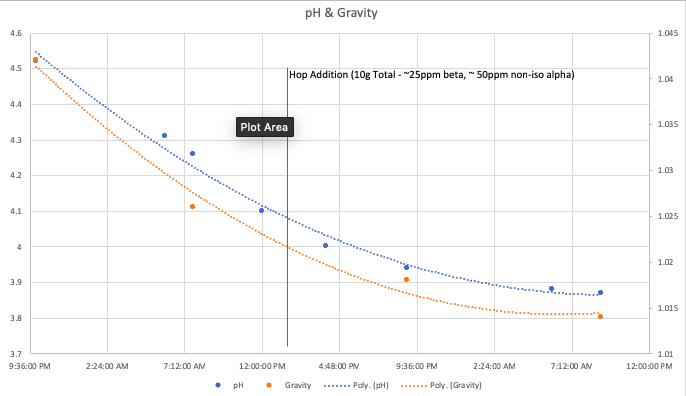Making sour beer doesn't need to be complicated!
These techniques are a good alternative to the antiquated kettle souring method.
Co-Souring Method:
- Make unhopped wort. Chill as normal.
- Pitch Lactobacillus plantarum and the yeast of your choice.
- Ferment as normal, at 65°F or higher.
- Optional/recommended add hops when it reaches the desired sourness. (Dry hops or hop tea)
- Package as normal.
Post-Souring Method:
Same as co-souring, except pitch the Lactobacillus after 1-2 days of fermentation (or 8-12 hours if using kveik and fermenting hot).
Post-souring is designed to maximize yeast flavor. It's great if you want to use an estery yeast like WLP644 (Sacc Trois) for example, which adds a nice tropical pineapple & mango profile.
FAQ
Q: Won't the Lacto ruin my equipment or contaminate my other beers?
A: No. Normal cleaning and sanitation procedures easily remove
L. plantarum. Furthermore,
L. plantarum is extremely hop-sensitive and will not sour your clean beers with hops, even if you directly add it. These techniques actually have LESS risk overall of contamination compared to kettle souring.
Q: Where do I get
L. plantarum?
A: Several sources are readily available in the US:
Swanson's L. plantarum capsules can be purchased online.
GoodBelly liquid probiotic and Renew Life Ultimate Flora are both widely available in stores. Many are now even keeping the Renew Life refrigerated, which is awesome. Lallemand offers pure
L. plantarum as WildBrew Sour Pitch. Other yeast labs sell Lacto blends of
L. plantarum mixed with other species, often
L. brevis (use these blends at your own risk because they are more hop-tolerant).
Store the Lacto in the refrigerator. The dry capsules will last a very long time.
Q: Do I need to make a starter for the Lacto?
A: It's not needed, however if you use the post-souring process, I do recommend a starter.
Starter procedure: After chilling, drain about 200-500mL wort into a sanitized jar. Add the Lacto and a few grams of calcium carbonate. Cover and let sit at room temp. When pitching, decant it off of the calcium carbonate (you don't want the chalk in your beer).
Q: How much Lacto do I pitch?
A: Pitch rate isn't very important. Feel free to use 1-2 capsules or a few ounces of GoodBelly in 5 gallons.
Q: Won't it take months to sour?
A. No.
L. plantarum sours quickly (within a couple days) anywhere in the range of 65-100°F. It will finish in the same timeframe as non-sour beer. I've gone from grain to packaging in 3 days.
Q: How long should I boil the wort?
A: Boiling is entirely optional since we don't need to isomerize alpha acids in hops. Mash temperature pasteurizes the wort.
Q: What amount of hops should I add?
A: Anywhere from 0.5 oz to 1 oz per 5 gallons adds a nice hop character (in my opinion) and completely inhibits further souring.
Q: Do the bacteria add flavor?
A: Generally, yes, depending on the source of
L. plantarum you use. Frequently the Lacto contributes a nice lemony citrus tartness, notes of berry and melon, and possibly some slight funk. Adding hops after reaching desired sourness will reduce the funk complexity. The Renew Life blend probably adds more flavor than a single species culture and it also creates a more funky profile when used at high temperature (e.g. when souring with kveik at 95°F).
Q: Will it continue to sour if I don't add hops?
A: Yes, possibly, but Lacto's ability to produce acid is self-limiting. Normally this species finishes around pH 3.1-3.3.
Q: What is hop tea?
A: Boil the hops for 5-10 minutes in 300-500mL of chlorine-free water. Dump it into your batch. If you add it at bottling, strain through a hop sock. Added bitterness will be minimal.
Q: Do I need a pH meter?
A: Not really. If you're inclined to stop the souring before it finishes naturally, you can do it by taste.
Q: Do I need to pre-acidify the wort?
A: Nope!
Q: Should I pitch more yeast than normal, or add yeast at bottling?
A: Nope!
Q: Can I use yeast cake from a previous batch?
A: Only if there were absolutely no hops in the batch from which you harvested it.
Q: Will the beer benefit from aging?
A: Nope!
Q: Is this beer probiotic?
A: Yes!
Please share your experience with these techniques. Happy to answer any questions!
Cheers!





























































